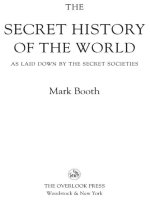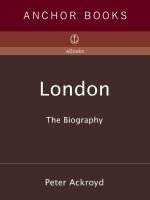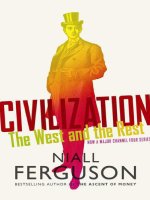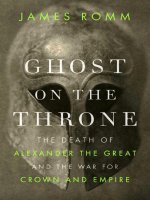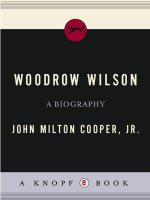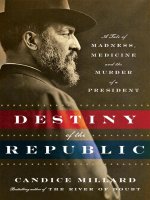Simon sebag montefiore jerusalem the biography (v5 0)
Bạn đang xem bản rút gọn của tài liệu. Xem và tải ngay bản đầy đủ của tài liệu tại đây (10.56 MB, 886 trang )
By the same author
Catherine the Great and Potemkin
Stalin: The Court of the Red Tsar
Young Stalin
Sashenka
JERUSALEM
THE BIOGRAPHY
Simon Sebag Montefiore
To my darling daughter
Lily Bathsheba
The view of Jerusalem is the history of the world; it is more; it is the history of heaven and earth.
Benjamin Disraeli, Tancred
The city has been destroyed, rebuilt, destroyed and rebuilt again. Jerusalem is an old nymphomaniac
who squeezes lover after lover to death, before shrugging him off her with a yawn, a black widow
who devours her mates while they are still penetrating her.
Amos Oz, A Tale of Love and Darkness
The Land of Israel is the centre of the world; Jerusalem is the centre of the Land; the Holy Temple is
the centre of Jerusalem; the Holy of Holies is the centre of the Holy Temple; the Holy Ark is the
centre of the Holy of Holies and the Foundation Stone from which the world was established is
before the Holy Ark.
Midrash Tanhuma, Kedoshim 10
The sanctuary of the earth is Syria; the sanctuary of Syria is Palestine; the sanctuary of Palestine is
Jerusalem; the sanctuary of Jerusalem is the Mount; the sanctuary of the Mount is the place of
worship; the sanctuary of the place of worship is the Dome of the Rock.
Thaur ibn Yazid, Fadail
Jerusalem is the most illustrious of cities. Still Jerusalem has some disadvantages. Thus it is reported
‘Jerusalem is a golden goblet full of scorpions’.
Muqaddasi, Description of Syria including Palestine
CONTENTS
List of Illustrations
List of Family Trees and Maps
Preface
Acknowledgements
Notes on Names, Transliterations and Titles
Prologue
PART ONE: JUDAISM
1. The World of David
2. The Rise of David
3. The Kingdom and the Temple
4. The Kings of Judah
5. The Whore of Babylon
6. The Persians
7. The Macedonians
8. The Maccabees
9. The Romans Arrive
10. The Herods
11. Jesus Christ
12. The Last of the Herods
13. Jewish Wars: The Death of Jerusalem
PART TWO: PAGANISM
14. Aelia Capitolina
PART THREE CHRISTIANITY
15. The Apogee of Byzantium
16. Sunset of the Byzantines: Persian Invasion
PART FOUR: ISLAM
17. The Arab Conquest
18. The Umayyads: The Temple Restored
19. The Abbasids: Distant Masters
20. The Fatimids: Tolerance and Lunacy
PART FIVE: CRUSADE
21. The Slaughter
22. The Rise of Outremer
23. The Golden Age of Outremer
24. Stalemate
25. The Leper-King
26. Saladin
27. The Third Crusade: Saladin and Richard
28. The Saladin Dynasty
PART SIX: MAMLUK
29. Slave to Sultan
30. Decline of the Mamluks
PART SEVEN: OTTOMAN
31. The Magnificence of Suleiman
32. Mystics and Messiahs
33. The Families
PART EIGHT: EMPIRE
34. Napoleon in the Holy Land
35. The New Romantics: Chateaubriand and Disraeli
36. The Albanian Conquest
37. The Evangelists
38. The New City
39. The New Religion
40. Arab City, Imperial City
41. Russians
PART NINE: ZIONISM
42. The Kaiser
43. The Oud-Player Of Jerusalem
44. World War
45. Arab Revolt, Balfour Declaration
46. The Christmas Present
47. The Victors And The Spoils
48. The British Mandate
49. The Arab Revolt
50. The Dirty War
51. Jewish Independence, Arab Catastrophe
52. Divided
53. Six Days
Epilogue
Family Trees
Maps
Notes
Bibliography
Index
Copyright
ILLUSTRATIONS
SECTION ONE
Aerial view of the Temple Mount (Albatross/Topfoto)
Tel Dan stele, c. 850 BC (Zev Radovan)
Ivory pomegranate, Israel Museum (AKG)
Section of Hezekiah’s wall (AKG)
The Siloam inscription, c. 700 BC, Istanbul Archaeological Museum (AKG)
Detail of relief from the palace of Sennacherib in Nineveh (AKG)
Detail of relief from the Treasury of the Palace of Persepolis (Bridgeman Art Library)
Coin discovered near Jericho, c. 333 BC (Zev Radovan)
Silver tetradrachm of Ptolemy I Soter, c. 300 BC, Israel Museum (AKG)
Silver tetradrachm of Antiochus IV Epiphanes, c. 175 BC, Israel Museum (AKG)
Judah the Maccabee
Silver denarius of Mark Antony and Cleopatra VII (The Trustees of the British Museum)
Reconstruction of the Second Temple, Israel Museum (AKG)
Ossuary of ‘Simon the builder of the Sanctuary’ (AKG)
Greek inscription from the temple, c.50 BC, Istanbul Archaeological Museum (AKG)
South-eastern corner of Herodian wall encircling the Temple Mount (Zev Radovan)
The Crucifixion, Hubert van Eyck, Ca’ d’Oro, Venice (Bridgeman Art Library)
Coin of Herod Antipas, c. AD 4–39, Israel Museum (AKG)
Coin of Herod Agrippa I, c. AD 43–39, Israel Museum (AKG)
Head of Titus, first century AD, Louvre Museum, Paris (Bridgeman Art Library)
Skeletal arm of young woman, AD 67 (Zev Radovan)
Rocks at the foot of the Wall, Jerusalem (author’s photograph)
Detail from the Arch of Titus, Rome (AKG)
Coin minted to commemorate victory over Judaea, AD 81 (Zev Radovan)
Bronze bust of Hadrian, c. 135, Israel Museum (Bridgeman Art Library)
Silver coin issued by Simon bar Kochba, c. 132–5, Israel Museum (AKG)
Fourth-century pilgrim graffiti, Church of the Holy Sepulchre (AKG)
Colossal head of Constantine the Great, Palazzo dei Conservatori, Rome (AKG)
SECTION TWO
Marble statue of Julian the Apostate, 362, Louvre Museum, Paris (AKG)
Justinian I and his retinue, c. 550, San Vitale, Ravenna (Bridgeman Art Library)
Theodora and her retinue, c. 550, San Vitale, Ravenna (Bridgeman Art Library)
Mosaic map of Palestine, Madaba (AKG)
The Golden Gate (author’s photograph)
Ascension of Muhammad, from a manuscript of Nizami’s poem ‘Khamza’, 1539–43, British
Library (AKG)
Umayyad dynasty gold dinar showing Abd al-Malik (The Trustees of the British Museum)
The Dome of the Rock (AKG)
Interior of the Dome of the Rock (Garo Nalbandian)
The looting of Jerusalem in 1099, illuminated miniature from a universal chronicle, Jean de
Courcy, Bibliotèque Nationale, Paris (Bridgeman Art Library)
Baldwin I crosses the Jordan, illumination from Roman de Godefroi de Bouillon, Bibliotèque
Nationale, Paris (AKG)
Medieval map of Jerusalem from Robert the Monk’s Chronicle of the Crusades (Corbis)
Melisende marrying Fulk of Anjou from the Histoire de la conquete de Jerusalem by William
of Tyre, Bibliotèque Nationale, Paris (Bridgeman Art Library)
Melisende’s psalter, c. 1131–43, British Library (AKG)
Baldwin IV and William of Tyre, illumination from Histoire de Outremer by William of Tyre,
British Library (AKG)
Portrait of Saladin, British Library (Bridgeman Art Library)
Frederick II entering Jerusalem, 1227, Vatican Library (AKG)
The Dome of Ascension (AKG)
Entrance to the Market of the Cotton Merchants
Qaitbay fountain (AKG)
Suleiman I, portrait attributed to school of Titian, c. 1530, Kunsthistorisches Museum, Vienna
(AKG)
Fountain of the Gate of the Chain (AKG)
Engraving of Sabbatai Zevi (AKG)
Detail from the exterior mosaics of the Dome of the Rock (Corbis)
SECTION THREE
Ibrahim Pasha, Charles-Philippe Larivière, Museum of French History at the Palace of
Versailles (RMN)
Greek Church of the Holy Sepulchre, David Roberts, 1839 (AKG)
Sir Moses Montefiore (author’s collection)
Montefiore windmill (Mishkenot Sha’ananim)
Photograph of the Church of the Holy Sepulchre, Patriarch Yessayi, 1861 (Armenian
Partriarchate)
A group of Yemenite Jews (American Colony)
A group of Ashkenazi Jews, 1885, Hulton Archive (Getty)
Crowd of Russian pilgrims at the Church of the Holy Sepulchre (American Colony)
King David Street, Granger Collection (Topfoto)
Theodor Herzl and his family, Hulton Archive (Getty)
Kaiser Wilhelm II in Jerusalem, 1889, Hulton Archive (Getty)
The Kaiser at the Tomb of the Kings (American Colony)
Bertha Spafford and other members of the American Colony with Bedouin friends, 1902
(American Colony)
Hussein Selim al-Husseini (American Colony)
Montagu Parker (Morley family archives)
Wasif Jawhariyyeh (Institute for Palestine Studies)
Jemal Pasha, 1915 (American Colony)
Turkish executions in Jerusalem (Mary Evans Picture Library)
Chaim Weizmann, 1918
David Lloyd George and Winston Churchill, 1910 (Getty)
T.E. Lawrence on the governor’s balcony, 1920 (Getty)
The Mayor of Jerusalem surrenders the city, 1917 (Getty)
Fourth of July reception at the American Colony (American Colony)
Winston Churchill, T. E. Lawrence and Amir Abdullah in the gardens of Government House,
1921, Matson Photograph Collection (Library of Congress, Washington, DC)
SECTION FOUR
Investiture by the Duke of Connaught in Barracks Square (American Colony)
Group outside Government House, 1924 (Israel State Archive)
King Hussein in Jerusalem, 1923 (Library of Congress, Washington, DC)
King Faisal and Amir Abdullah surrounded by students, 1933, Matson Photograph Collection
(Library of Congress, Washington, DC)
David Ben-Gurion, 1924 (Mary Evans Picture Library)
Mufti Amin al-Husseini at the Nabi Musa festival, 1937 (Keystone Press, France)
Holy Fire ceremony, 1941, Matson Photograph Collection (Library of Congress, Washington,
DC)
Prayers at the Western Wall, 1944 (Central Zionist Archives)
Asmahan (Getty)
Mufti Amin al-Husseini meets Adolf Hitler, 1941 (AKG)
Abd al-Kadir al-Husseini, 1940s (Associated Press)
Abd al-Kadir al-Husseini’s funeral procession, 1948 (Government Press Office, State of Israel)
Bombing of the King David Hotel
Katy Antonius (Palestinian Academic Society for the Study of International Affairs)
Jerusalem in smoke during the Arab–Israeli War, 28 May 1948 (Mary Evans Picture Library)
Arab soldiers escorting a Jewish prisoner, 1 June 1948, Time and Life Pictures (Getty)
Jewish girl fleeing from burning buildings, 28 May 1948, Time and Life Pictures (Getty)
Arab troops behind sandbag barricades, 1 June 1948 (AKG)
King Abdullah with crowds in Jerusalem, 1 July 1948 (Getty)
The scene in al-Aqsa mosque after King Abdullah’s assassination, 20 July 1951 (Associated
Press)
King Hussein of Jordan, 29 July 1967 (Associated Press)
Yitzhak Rabin and Moshe Dayan during an Israeli cabinet meeting, 1967 (Micha Bar
Am/Magnum Photos)
Israeli paratroopers advancing to Lions’ Gate, 7 June 1967 (Avner Offer)
Israeli soldiers praying at the Western Wall, 7 June 1967 (Cornell Capa/Magnum Photos)
The sheikh in charge of the mosques on the Temple Mount, 7 June 1967 (Micha Bar Am/Magnum
Photos)
Israeli troops making their way towards al-Aqsa (Micha Bar Am/Magnum Photos)
Israeli paratroopers at the Dome of the Rock (Avner Offer)
FAMILY TREES
The Maccabees: Kings and High Priests, 160–37 BC
The Herods, 37 BC–AD 100
The Prophet Muhammad and the Islamic Caliphs and Dynasties
Crusader Kings of Jerusalem, 1099–1291
The Hashemite (Sherifian) Dynasty, 1916–
MAPS
The Kingdom of David and Solomon, and the Kingdoms of Israel and Judah, 1000–586 BC
The Empires, 586 BC–AD 1918
Jerusalem in the First Century AD and Jesus’ Passion
The Crusader Kingdoms, 1098–1489
Mamluk and Ottoman Jerusalem, 1260–1917
The Sykes-Picot Plan, 1916
Sherif Hussein’s Imperial Dream, 1916
UN Plan, 1947
Israel since 1948
Jerusalem: The Old City
Jerusalem in the Early Twentieth Century
PREFACE
The history of Jerusalem is the history of the world, but it is also the chronicle of an often penurious
provincial town amid the Judaean hills. Jerusalem was once regarded as the centre of the world and
today that is more true than ever: the city is the focus of the struggle between the Abrahamic religions,
the shrine for increasingly popular Christian, Jewish and Islamic fundamentalism, the strategic
battlefield of clashing civilizations, the front line between atheism and faith, the cynosure of secular
fascination, the object of giddy conspiracism and internet myth-making, and the illuminated stage for
the cameras of the world in the age of twenty-four-hour news. Religious, political and media interest
feed on each other to make Jerusalem more intensely scrutinized today than ever before.
Jerusalem is the Holy City, yet it has always been a den of superstition, charlatanism and bigotry;
the desire and prize of empires, yet of no strategic value; the cosmopolitan home of many sects, each
of which believes the city belongs to them alone; a city of many names – yet each tradition is so
sectarian it excludes any other. This is a place of such delicacy that it is described in Jewish sacred
literature in the feminine – always a sensual, living woman, always a beauty, but sometimes a
shameless harlot, sometimes a wounded princess whose lovers have forsaken her. Jerusalem is the
house of the one God, the capital of two peoples, the temple of three religions and she is the only city
to exist twice – in heaven and on earth: the peerless grace of the terrestrial is as nothing to the glories
of the celestial. The very fact that Jerusalem is both terrestrial and celestial means that the city can
exist anywhere: new Jerusalems have been founded all over the world and everyone has their own
vision of Jerusalem. Prophets and patriarchs, Abraham, David, Jesus and Muhammad are said to have
trodden these stones. The Abrahamic religions were born there and the world will also end there on
the Day of Judgement. Jerusalem, sacred to the Peoples of the Book, is the city of the Book: the Bible
is, in many ways, Jerusalem’s own chronicle and its readers, from the Jews and early Christians via
the Muslim conquerors and the Crusaders to today’s American evangelists, have repeatedly altered
her history to fulfil biblical prophecy.
When the Bible was translated into Greek then Latin and English, it became the universal book and
it made Jerusalem the universal city. Every great king became a David, every special people were the
new Israelites and every noble civilization a new Jerusalem, the city that belongs to no one and exists
for everyone in their imagination. And this is the city’s tragedy as well as her magic: every dreamer
of Jerusalem, every visitor in all ages from Jesus’ Apostles to Saladin’s soldiers, from Victorian
pilgrims to today’s tourists and journalists, arrives with a vision of the authentic Jerusalem and then
is bitterly disappointed by what they find, an ever-changing city that has thrived and shrunk, been
rebuilt and destroyed many times. But since this is Jerusalem, property of all, only their image is the
right one; the tainted, synthetic reality must be changed; everyone has the right to impose their
‘Jerusalem’ on Jerusalem – and, with sword and fire, they often have.
Ibn Khaldun, the fourteenth-century historian who is both participant and source for some of the
events related in this book, noted that history is so ‘eagerly sought after. The men in the street aspire
to know it. Kings and leaders vie for it.’ This is especially true for Jerusalem. It is impossible to
write a history of this city without acknowledging that Jerusalem is also a theme, a fulcrum, a spine
even, of world history. At a time when the power of internet mythology means that the hi-tech mouse
and the curved sword can both be weapons in the same fundamentalist arsenal, the quest for historical
facts is even more important now than it was for Ibn Khaldun.
A history of Jerusalem must be a study of the nature of holiness. The phrase ‘Holy City’ is
constantly used to describe the reverence for her shrines, but what it really means is that Jerusalem
has become the essential place on earth for communication between God and man.
We must also answer the question: of all the places in the world, why Jerusalem? The site was
remote from the trade routes of the Mediterranean coast; it was short of water, baked in the summer
sun, chilled by winter winds, its jagged rocks blistered and inhospitable. But the selection of
Jerusalem as the Temple city was partly decisive and personal, partly organic and evolutionary: the
sanctity became ever more intense because she had been holy for so long. Holiness requires not just
spirituality and faith but also legitimacy and tradition. A radical prophet presenting a new vision must
explain the centuries that have gone before and justify his own revelation in the accepted language
and geography of holiness – the prophecies of earlier revelations and the sites already long revered.
Nothing makes a place holier than the competition of another religion.
Many atheistic visitors are repelled by this holiness, seeing it as infectious superstition in a city
suffering a pandemic of righteous bigotry. But that is to deny the profound human need for religion
without which it is impossible to understand Jerusalem. Religions must explain the fragile joys and
perpetual anxieties that mystify and frighten humanity: we need to sense a greater force than
ourselves. We respect death and long to find meaning in it. As the meeting-place of God and man,
Jerusalem is where these questions are settled at the Apocalypse – the End of Days, when there will
be war, a battle between Christ and anti-Christ, when the Kaaba will come from Mecca to Jerusalem,
when there will be judgement, resurrection of the dead and the reign of the Messiah and the Kingdom
of Heaven, the New Jerusalem. All three Abrahamic religions believe in the Apocalypse, but the
details vary by faith and sect. Secularists may regard all this as antique gobbledegook, but, on the
contrary, such ideas are all too current. In this age of Jewish, Christian and Muslim fundamentalism,
the Apocalypse is a dynamic force in the world’s febrile politics.
Death is our constant companion: pilgrims have long come to Jerusalem to die and be buried around
the Temple Mount to be ready to rise again in the Apocalypse, and they continue to come. The city is
surrounded by and founded upon cemeteries; the wizened body-parts of ancient saints are revered –
the desiccated blackened right hand of Mary Magdalene is still displayed in the Greek Orthodox
Superior’s Room in the Church of the Holy Sepulchre. Many shrines, even many private houses, are
built around tombs. The darkness of this city of the dead stems not just from a sort of necrophilia, but
also from necromancy: the dead here are almost alive, even as they await resurrection. The unending
struggle for Jerusalem – massacres, mayhem, wars, terrorism, sieges and catastrophes – have made
this place into a battlefield, in Aldous Huxley’s words the ‘slaughterhouse of the religions’, in
Flaubert’s a ‘charnel-house’. Melville called the city a ‘skull’ besieged by ‘armies of the dead’;
while Edward Said remembered that his father had hated Jerusalem because it ‘reminded him of
death’.
This sanctuary of heaven and earth did not always evolve providentially. Religions begin with a
spark revealed to one charismatic prophet – Moses, Jesus, Muhammad. Empires are founded, cities
conquered, by the energy and luck of one warlord. The decisions of individuals, starting with King
David, made Jerusalem into Jerusalem.
There was surely scant prospect that David’s little citadel, capital of a small kingdom, would
become the world’s cynosure. Ironically it was Nebuchadnezzar’s destruction of Jerusalem that
created the template for holiness because that catastrophe led the Jews to record and acclaim the
glories of Zion. Such cataclysms usually led to the vanishing of peoples. Yet the Jews’ exuberant
survival, their obstinate devotion to their God and, above all, their recording of their version of
history in the Bible laid the foundation for Jerusalem’s fame and sanctity. The Bible took the place of
the Jewish state and the Temple and became, as Heinrich Heine put in, the ‘portable fatherland of the
Jews, the portable Jerusalem’. No other city has its own book and no other book has so guided the
destiny of a city.
The sanctity of the city grew out of the exceptionalism of the Jews as the Chosen People. Jerusalem
became the Chosen City, Palestine the Chosen Land, and this exceptionalism was inherited and
embraced by the Christians and the Muslims. The paramount sanctity of Jerusalem and of the land of
Israel was reflected in the growing religious obsession with the restoration of the Jews to Israel and
the Western enthusiasm for Zionism, its secular equivalent, between the sixteenth-century
Reformation in Europe and the 1970s. Since then, the tragic narrative of the Palestinians, with
Jerusalem as their lost Holy City, has altered the perception of Israel. Thus Western fixation, this
sense of universal ownership, can work both ways – it is a mixed blessing or a double-edged sword.
Today it is reflected in the scrutiny of Jerusalem and the Israel–Palestine conflict, more intense, more
emotional than any other on earth.
Yet nothing is quite as simple it seems. The history is often presented as a series of brutal changes
and violent reversals but I want to show that Jerusalem was a city of continuity and co-existence, a
hybrid metropolis of hybrid buildings and hybrid people who defy the narrow categorizations that
belong in the separate religious legends and nationalist narratives of later times. That is why,
wherever possible, I follow the history through families – the Davidians, Maccabees and Herodians,
the Umayyads and the houses of Baldwin and Saladin, up to the Husseinis, Khalidis, Spaffords,
Rothschilds and Montefiores – which reveal the organic patterns of life that defy the abrupt incidents
and sectarian narratives of conventional history. There are not just two sides in Jerusalem but many
interlinked, overlapping cultures and layered loyalties – a multi-faceted, mutating kaleidoscope of
Arab Orthodox, Arab Muslims, Sephardic Jews, Ashkenazi Jews, Haredi Jews of legion courts,
secular Jews, Armenian Orthodox, Georgians, Serbs, Russians, Copts, Protestants, Ethiopians, Latins
and so on. A single individual often had several loyalties to different identities, the human equivalent
of Jerusalem’s layers of stone and dust.
In fact, the city’s relevance has ebbed and flowed, never still, always in a state of transformation,
like a plant that changes shape, size, even colour, yet always remains rooted in the same place. The
latest, glib manifestation – Jerusalem as media ‘Holy City sacred to three religions’ and twenty-fourhour-news show – is relatively recent. There have been centuries when Jerusalem seemed to lose
religious and political importance. In many cases, it was political necessity, not divine revelation,
that again stimulated and inspired religious devotion.
Whenever Jerusalem has seemed most forgotten and irrelevant, it was often the bibliolatry, the
devoted study of biblical truth by people in faraway lands – whether in Mecca, Moscow,
Massachusetts – who projected their faith back on to Jerusalem. All cities are windows into foreign
mindsets but this one is also a two-way mirror revealing her inner life while reflecting the world
outside. Whether it was the epoch of total faith, righteous empire-building, evangelical revelation or
secular nationalism, Jerusalem became its symbol, and its prize. But like the mirrors in a circus, the
reflections are always distorted, often freakish.
Jerusalem has a way of disappointing and tormenting both conquerors and visitors. The contrast
between the real and heavenly cities is so excruciating that a hundred patients a year are committed to
the city’s asylum, suffering from the Jerusalem Syndrome, a madness of anticipation, disappointment
and delusion. But Jerusalem Syndrome is political too: Jerusalem defies sense, practical politics and
strategy, existing in the realm of ravenous passions and invincible emotions, impermeable to reason.
Even victory in this struggle for dominance and truth merely intensifies the city’s holiness for others.
The greedier the possessor, the fiercer the competition, the more visceral the reaction. The law of
unintended consequences reigns here.
No other place evokes such a desire for exclusive possession. Yet this jealous zeal is ironic since
most of Jerusalem’s shrines, and the stories that go with them, have been borrowed or stolen,
belonging formerly to another religion. The city’s past is often imaginary. Virtually every stone once
stood in the long-forgotten temple of another faith, the victory arch of another empire. Most, but not
all, conquests have been accompanied by the instinct to expunge the taint of other faiths while
commandeering their traditions, stories, sites. There has been much destruction, but more often the
conquerors have not destroyed what came before but reused and added to it. The important sites such
as the Temple Mount, the Citadel, the City of David, Mount Zion and the Church of the Holy
Sepulchre do not present distinct layers of history but are more like palimpsests, works of
embroidery in which the silk threads are so interwoven it is now impossible to separate them.
The competition to possess the infectious holiness of others has led some shrines to become holy to
all three of the religions successively then simultaneously; kings have decreed and men died for them
– and yet they are now almost forgotten: Mount Zion has been the site of frenzied Jewish, Muslim and
Christian reverence but now there are few Muslim or Jewish pilgrims, and it is mainly Christian
again.
In Jerusalem, the truth is often much less important than the myth. ‘In Jerusalem, don’t ask me the
history of facts,’ says the eminent Palestinian historian Dr Nazmi al-Jubeh. ‘Take away the fiction
and there’s nothing left.’ History is so pungently powerful here that it is repeatedly distorted:
archaeology is itself a historical force and archaeologists have at times wielded as much power as
soldiers, recruited to appropriate the past for the present. A discipline that aims to be objective and
scientific can be used to rationalize religious-ethnic prejudice and justify imperial ambitions. Israelis,
Palestinians and the evangelical imperialists of the nineteenth century have all been guilty of
commandeering the same events and assigning them contradictory meanings and facts. So a history of
Jerusalem has to be a history of both truth and legend. But there are facts and this book aims to tell
them, however unpalatable to one side or the other.
My aim here is to write the history of Jerusalem in its broadest sense for general readers, whether
they are atheists or believers, Christians, Muslims or Jews, without a political agenda, even in
today’s strife.
I tell the story chronologically, through the lives of the men and women – soldiers and prophets,
poets and kings, peasants and musicians – and the families who made Jerusalem. I think this is the
best way to bring the city to life and to show how its complex and unexpected truths are the result of
this history. It is only by chronological narrative that one avoids the temptation to see the past through
the obsessions of the present. I have tried to avoid teleology – writing history as if every event were
inevitable. Since each mutation is a reaction to the one that preceded it, chronology is the best way to
make sense of this evolution, answer the question – why Jerusalem? – and show why people acted the
way they did. I hope this is also the most entertaining way to tell it. Who am I to ruin a story that – to
use a Hollywood cliché that is, in this case, merited – is the greatest ever told? Among thousands of
books on Jerusalem, there are very few narrative histories. Four epochs – David, Jesus, the Crusades
and the Arab–Israeli conflict – are familiar, thanks to the Bible, movies, novels and the news, but they
are still frequently misunderstood. As for the rest, I dearly wish to bring much forgotten history to
new readers.
This is a history of Jerusalem as the centre of world history, but it is not intended to be an
encyclopaedia of every aspect of Jerusalem, nor a guidebook of every niche, capital and archway in
every building. This is not a minute history of the Orthodox, Latins or Armenians, the Islamic Hanafi
or Shafii schools of law, the Hasidic or the Karaite Jews, nor is it told from any specific point of
view. The life of the Muslim city from Mamluks to the Mandate has been neglected. The Jerusalem
Families have been studied by academics of the Palestinian experience, but scarcely covered by
popular historians. Their histories have been and remain extremely important: some key sources are
not yet available in English, but I have had them translated and I have interviewed the family
members of all these clans in order to learn their stories. But they are only part of the mosaic. This is
not a history of Judaism, Christianity or Islam, nor a study of the nature of God in Jerusalem: all these
have been expertly done by others – most recently in Karen Armstrong’s excellent Jerusalem: One
City, Three Faiths . Nor is this a detailed history of the Israel–Palestine conflict: no subject today is
so obsessively studied. But my daunting challenge is to cover all these things, I hope in proportion.
My task is to pursue the facts, not to adjudicate between the mysteries of different religions. I
certainly do not claim the right to judge whether the divine wonders and sacred texts of the three great
religions are ‘true’. Anyone who studies the Bible or Jerusalem has to recognize that there are many
levels of truth. The beliefs of other religions and other epochs seem strange to us, while the familiar
customs of our own time and place always appear eminently reasonable. Even the twenty-first
century, which many seem to regard as the very acme of secular reason and common sense, has its
own conventional wisdoms and quasi-religious orthodoxies that will appear incomprehensibly
absurd to our great-grandchildren. But the effect of the religions and their miracles on the history of
Jerusalem is undeniably real, and it is impossible to know Jerusalem without some respect for
religion.
There are centuries of Jerusalem’s history when little is known and everything is controversial.
Being Jerusalem, the academic and archaeological debates are always venomous and sometimes
violent, even leading to riots and fighting. Events in the last half-century are so controversial that
there are many versions of them.
In the early period, historians, archaeologists and cranks alike have squeezed, moulded and
manhandled the very few sources available to fit every possible theory which they have then
advocated with all the confidence of absolute certainty. In all cases, I have reviewed the original
sources and the many theories and come to a conclusion. If I covered myself comprehensively in
every case, the most common words in this book would be ‘maybe’, ‘probably’, ‘might’ and ‘could’.
I have therefore not included them on every appropriate occasion but I ask the reader to understand
that behind every sentence is a colossal, ever-changing literature. Each section has been checked and
read by an academic specialist. I am fortunate that I have been helped in this by some of the most
distinguished professors at work today.
The most fraught of these controversies is that of King David, because its political implications are
so charged and so contemporary. Even at its most scientific, this debate has been conducted more
dramatically and with greater harshness than one would find in any other place on any other subject,
except perhaps the natures of Christ or Muhammad. The source for the story of David is the Bible.
His historical life was long taken for granted. In the nineteenth century, the imperialistic-Christian
interest in the Holy Land inspired the archaeological quest for David’s Jerusalem. The Christian
nature of this investigation was redirected by the creation of the State of Israel in 1948 which gave it
passionate religious-political significance because of David’s status as the founder of Jewish
Jerusalem. In the absence of much evidence of the tenth century, revisionist Israeli historians
downsized David’s city. Some even questioned whether he was a historical character at all, much to
the outrage of Jewish traditionalists and to the glee of Palestinian politicians, because it undermined
the Jewish claim. But the discovery of the Tel Dan stele in 1993 proved that King David did exist.
The Bible, though not written primarily as history, is nonetheless a historical source which I have
used to tell the story. The extent of David’s city and the trustworthiness of the Bible are discussed in
the text and for the present conflict over the City of David, see the Epilogue.
Much later, it is impossible to write about the nineteenth century without feeling the shadow of
Edward Said’s Orientalism. Said, a Palestinian Christian born in Jerusalem who became a literary
professor at Columbia University in New York and an original political voice in the world of
Palestinian nationalism, argued that the ‘subtle and persistent Eurocentric prejudice against AraboIslamic peoples and their culture’, particularly among nineteenth-century travellers such as
Chateaubriand, Melville and Twain, had diminished Arab culture and justified imperialism.
However, Said’s own work inspired some of his acolytes to try to airbrush these Western intruders
out of the history: this is absurd. It is true, however, that these visitors saw and understood little of the
real life of Arab and Jewish Jerusalem and, as explained above, I have worked hard to show the
actual lives of the indigenous population. But this book is not a polemic and the historian of
Jerusalem must show the dominating influence of Western romantic-imperial culture towards the city
because it explains why the Middle East so mattered to the Great Powers.
Similarly, I have portrayed the progress of British pro-Zionism, secular and evangelical, from
Palmerston and Shaftesbury to Lloyd George, Balfour, Churchill and their friend Weizmann for the
simple reason that this was the single most decisive influence on the fate of Jerusalem and Palestine
in the nineteenth and twentieth centuries.
I end the main body of the book in 1967 because the Six Day War essentially created the situation
today and it provides a decisive stop. The Epilogue cursorily brings the politics up to the present and
ends with a detailed portrait of a typical morning in the three Holy Places. But the situation is ever
changing. If I were to continue the history in detail up to today, the book would lack any clear ending
and have to be updated almost hourly. Instead I have tried to show why Jerusalem continues to be
both the essence of and obstacle to a peace deal.
This work is a synthesis based on a wide reading of the primary sources, ancient and modern, on
personal seminars with specialists, professors, archaeologists, families and statesmen, and on
innumerable visits to Jerusalem, the shrines and archaeological digs. I have been fortunate to uncover
some new or rarely used sources. My research has brought three special joys: that of spending much
time in Jerusalem; that of reading the wondrous works of writers from Usamah bin Munqidh, Ibn
Khaldun, Evliya Celebi and Wasif Jawhariyyeh to William of Tyre, Josephus and T. E. Lawrence;
and, thirdly, that of being befriended and helped, with such trust and generosity, amid ferocious
political crises, by Jerusalemites of all sects – Palestinians, Israelis and Armenians, Muslims, Jews
and Christians.
I feel I have been preparing to write this book all my life. Since childhood, I have been wandering
around Jerusalem. Because of a family connection, related in the book, ‘Jerusalem’ is my family
motto. Whatever the personal link, I am here to recount the history of what happened and what people
believed. To return to where we started, there have always been two Jerusalems, the temporal and the
celestial, both ruled more by faith and emotion than by reason and facts. And Jerusalem remains the
centre of the world.
Not everyone will like my approach – after all, this is Jerusalem. But in writing the book I always
remembered Lloyd George’s advice to his Governor of Jerusalem, Storrs, who was being savagely
criticized by both Jews and Arabs: ‘Well, if either one side stops complaining, you’ll be dismissed.’1
ACKNOWLEDGEMENTS
I have been helped in this huge project by a wide cast of scholars outstanding in their fields. I am
deeply grateful to them for their help, advice and, where stated, reading and correcting of my text.
In the archaeological–biblical period, thank you, above all, to the following for reading and
correcting this section: Professor Ronny Reich; Professor Dan Bahat, formerly the Chief
Archaeologist of Jerusalem, who also gave me detailed tours of the city; Dr Raphael Greenberg, who
likewise treated me to site visits; and Rosemary Eshel. Thanks for help and advice to Irving Finkel,
Assistant Keeper of Ancient Iraq and magical-medical texts at the British Museum; and to Dr Eleanor
Robson, Reader in Ancient Middle Eastern Science, Department of History and Philosophy of
Science, Cambridge University, for her correction of the sections on Assyria–Babylon–Persia, and Dr
Nicola Schreiber for her advice on the pottery implications for the dating of the gateways of
Megiddo; to Dr Gideon Avni, Director of Excavations and Surveys Department, IAA; Dr Eli Shukron,
for his regular tours of the dig in the City of David; Dr Shimon Gibson; Dr Renee Sivan of the
Citadel. And special thanks to Dr Yusuf al-Natsheh, Director of the Department of Islamic
Archaeology of the Haram al-Sharif, for his help throughout the project and for arranging access to
closed sites on the Haram and tours with Khader al-Shihabi. On the Herodian–Roman–Byzantine
period, I am immensely grateful to Professor Martin Goodman of Oxford University and to Dr Adrian
Goldsworthy for the reading and correction of my text.
On the early Islamic period, Arabs, Turks and Mamluks, I owe huge thanks for his advice, guidance
and detailed correction of my text to Hugh Kennedy, Professor of Arabic at the School of Oriental and
African Studies (SOAS), and also to Dr Nazmi al-Jubeh, Dr Yusuf al-Natsheh and Khader al-Shihabi.
On the Mamilla Cemetery, I thank Taufik De’adel.
On the Crusades: thanks to Professor Jonathan Riley-Smith, Professor of Ecclesiastical History,
Cambridge University, and to Professor David Abulafia, Professor of Mediterranean History,
Cambridge University, for reading and correcting the text.
On Jewish history from the Fatimids to the Ottomans: thanks to Professor Abulafia who gave me
access to manuscript sections of his Great Sea: A Human History of the Mediterranean, to Professor
Minna Rozen, Haifa University, and to Sir Martin Gilbert, who let me read the manuscript of In
Ishmael’s House.
On the Ottoman period and the Palestinian Jerusalem Families: thanks to Professor Adel Manna,
who read and corrected the text of the sixteenth-, seventeenth- and eighteenth-century sections.
On the nineteenth-century–imperialist–early-Zionist periods: thanks to Yehoshoa Ben-Arieh; Sir
Martin Gilbert; Professor Tudor Parfitt; Caroline Finkel; Dr Abigail Green, who let me read her
manuscript Moses Montefiore: Jewish Liberator, Imperial Hero ; and Bashir Barakat, for his private
research on the Jerusalem Families. Kirsten Ellis generously gave me access to unpublished chapters
of Star of the Morning. Dr Clare Mouradian gave me much advice and material. Professor Minna
Rozen shared her research on Disraeli and other papers. On the Russian connection, thanks to
Professor Simon Dixon, and to Galina Babkova in Moscow; and on the Armenians to George Hintlian
and Dr Igor Dorfmann-Lazarev.
On the Zionist period, the twentieth century and the Epilogue: I owe the greatest thanks to Dr Nadim
Shehadi, Associate Fellow of the Middle East Programme, Chatham House, and to Professor Colin
Shindler, SOAS, both of whom read and corrected these entire sections. I am grateful to David and
Jackie Landau of the Economist and Haaretz for their corrections. Thanks to Dr Jacques Gautier; to
Dr Albert Aghazarian; to Jamal al-Nusseibeh for ideas and contacts; to Huda Imam for her tour of the
Security Wall; to Yakov Loupo for his research on the ultra-Orthodox.
I owe much to Dr John Casey of Gonville and Caius College, Cambridge, who nobly and
mercilessly corrected the entire text, as did George Hintlian, historian of the Ottoman period,
Secretary of the Armenian Patriarchate 1975–95. Special thanks to Maral Amin Quttieneh for her
translation of Arabic materials into English.
Thanks for advice and family history to the following members of the Jerusalem Families
interviewed or consulted: Muhammad al-Alami, Nasseredin al-Nashashibi, Jamal al-Nusseibeh, Zaki
al-Nusseibeh, Wajeeh al-Nusseibeh, Saida al-Nusseibeh, Mahmoud al-Jarallah, Huda Imam of the
Jerusalem Institute, Haifa al-Khalidi, Khader al-Shihabi, Said al-Husseini, Ibrahim al-Husseini,
Omar al-Dajani, Aded al-Judeh, Maral Amin Quttieneh, Dr Rajai M. al-Dajani, Ranu al-Dajani,
Adeb al-Ansari, Naji Qazaz, Yasser Shuki Toha, owner of my favourite Abu Shukri restaurant;
Professor Rashid Khalidi of Columbia University.
Thanks to Shmuel Rabinowitz, Rabbi of the Western Wall and the Holy Sites; to Father Athanasius
Macora of the Catholics, Father Samuel Aghoyan, Armenian Superior of the Church of the Holy
Sepulchre, Father Afrayem Elorashamily of the Copts, Syriac Bishop Severius, Syriac Father Malke
Morat.
I am grateful to Shimon Peres, the President of the State of Israel, and Lord Weidenfeld, both of
whom shared memories and ideas; to Princess Firyal of Jordan for her memories of Jordanian
Jerusalem; and to Prince and Princess Talal bin Muhammad of Jordan.
Thanks to HRH the Duke of Edinburgh for his advice and for checking the text on his mother
Princess Andrew of Greece and his aunt Grand Duchess Ella; and to HRH the Prince of Wales. I am
especially grateful for access to their private family archives to the Earl of Morley and to the Hon.
and Mrs Nigel Parker for their charming hospitality.
Yitzhak Yaacovy was the man who introduced me to Jerusalem: survivor of Auschwitz, fighter in
the 1948 War of Independence, man of letters, young aide in Ben-Gurion’s office, he was the longserving Chairman of the East Jerusalem Development Company under Mayor Teddy Kollek.
The envoys of both the State of Israel and the Palestinian Authority were immensely generous in
time, ideas, information and conversation: thanks to Ron Prosor, the Israeli Ambassador to London,
Rani Gidor, Sharon Hannoy and Ronit Ben Dor at the Israeli Embassy; Professor Manuel Hassassian,
the Palestinian Authority Ambassador in London.
William Dalrymple and Charles Glass were both extremely generous throughout this project with
ideas, materials and reading-lists. The Jerusalem Foundation was incredibly helpful: thanks to Ruth
Chesin, Nurit Gordon, Alan Freeman and Uri Dromi, Director of Mishkenot Shaanim. No one helped
as much with academic and other contacts as John Levy of the Friends of Israel Educational
Foundation and of the Academic Study Group, and Ray Bruce, veteran television producer.
Thanks to Peter Sebag-Montefiore and his daughter Louise Aspinall for sharing Geoffrey SebagMontefiore’s papers; to Kate Sebag-Montefiore for research into William Sebag-Montefiore’s
adventures.
Thanks for help, advice, encouragement to: Amos and Nily Oz, Munther Fahmi at the American
Colony Bookshop, Philip Windsor-Aubrey, David Hare, David Kroyanker, Hannah Kedar, Fred
Iseman, Lea Carpenter Brokaw, Danna Harman, Dorothy and David Harman, Caroline Finkel,
Lorenza Smith, Professor Benjamin Kedar, Yaov Farhi, Diala Khlat, Ziyad Clot, Youssef Khlat,
Rania Joubran, Rebecca Abram, Sir Rocco and Lady Forte, Kenneth Rose, Dorrit Moussaeff and her
father Shlomo Moussaeff, Sir Ronald and Lady Cohen, David Khalili, Richard Foreman, Ryan Prince,
Tom Holland, Tarek Abu Zayyad, Professor Israel Finkelstein, Professor Avigdor Shinan, Professor
Yair Zakovitch, Jonathan Foreman, Musa Klebnikoff, Arlene Lascona, Ceri Aston, Rev. Robin
Griffith-Jones, the Master of the Temple, Hani Abu Diab, Miriam Ovits, Joana Schliemann, Sarah
Helm, Professor Simon Goldhill, Dr Dorothy King, Dr Philip Mansel, Sam Kiley, John Micklethwait,
editor of the Economist, Gideon Lichfield, Rabbi Mark Winer, Maurice Bitton, the Curator of Bevis
Marks Synagogue, Rabbi Abraham Levy, Professor Harry Zeitlin, Professor F. M. al-Eloischari,
Melanie Fall, Rabbi David Goldberg, Melanie Gibson, Annabelle Weidenfeld, Adam, Gill, David
and Rachel Montefiore, Dr Gabriel Barkey, Marek Tamm, Ethan Bronner of the New York Times ,
Henry Hemming, William Sieghart. Thanks to Tom Morgan for help with the research.
Thanks to my agent Georgina Capel and my international rights agents Abi Gilbert and Romily Must;
to my British publishers Alan Samson, Ion Trewin and Susan Lamb, my brilliant editor Bea Hemming
at Weidenfeld; and to Peter James, the master of copy-editors; to my most longstanding publishers:
Sonny Mehta at Knopf; in Brazil to Luiz Schwarz and Ana Paula Hisayama at Companhía das Letras;
in France, Mireille Paoloni at Calmann Lévy; in Germany, Peter Sillem at Fischer; in Israel, Ziv
Lewis at Kinneret; in Holland, Henk van ter Borg, at Nieuw Amsterdam; in Norway, Ida Bernsten and
Gerd Johnsen at Cappelens; in Poland, Jolanta Woloszanska at Magnum; in Portugal, Alexandra
Louro at Alêtheia Editores; in Spain, Carmen Esteban at Crítica; in Estonia, Krista Kaer of Varrak;
and in Sweden, Per Faustino and Stefan Hilding at Norstedts.
My parents Dr Stephen and April Sebag-Montefiore have been superb editors of all my books.
Above all I want to thank my wife Santa, who has been the patient, encouraging and loving sultana of
this long process. Santa and my children Lily and Sasha have, like me, undoubtedly suffered the full
effects of the Jerusalem Syndrome. They may never recover, but they probably know more about the
Rock, the Wall and the Sepulchre than many a priest, rabbi or mullah.
NOTES ON NAMES,
TRANSLITERATIONS AND TITLES
This book inevitably contains a challenging diversity of names, languages and questions of
transliteration. It is for general readers, so my policy is to use the most accessible and familiar
names. I apologize to purists who are offended by these decisions.
In the Judaean period, I generally use the Greek not the Latin or Hebrew names for the Hasmonean
kings – Aristobulos, for example. With minor characters such as Herod’s brother-in-law I use his
Hebrew name Jonathan instead of his Greek one, Aristobulos, to avoid confusion with the many other
Aristobuloses. With household names, I use the familiar – Herod (not Herodes), Pompey, Mark
Antony, Tamurlane, Saladin. For Persian names, if well known such as Cyrus, I use that version. The
Maccabean family reigned as the Hasmonean dynasty, but I call them Maccabean throughout for the
sake of clarity.
In the Arab period, the challenges are greater. I do not pretend to be consistent. I generally use
familiar English forms – such as Damascus rather than Dimashq. I have dropped the Arabic article
‘al-’ before persons, groups and towns but kept it on the whole within compound names and for the
first mention of names in the text and the notes and not thereafter. I do not use diacritical marks. Most
of the Abbasid and Fatamid caliphs and Ayyubid sultans adopted a regnant name, a laqab, such as alMansur. Purely to ease reading, I drop in all cases the definite article. I use ‘ibn’ instead of ‘bin’
except in well-known names. In names such as Abu Sufyan, I do not use the Arabic genitive (which
would give, for example, Muawiya ibn Abi Sufyan), again for facility. I generally call the Ayyubids
the ‘house of Saladin’.
There is no consistency in the Western historical use of Arab names – for example, the Abbasids
are known by their ruling names apart from Harun al-Rashid because he is famous thanks to the
Arabian Nights stories. All historians use the name Saladin for the twelfth-century sultan yet call his
brother al-Adil. Saladin’s birth name was Yusuf ibn Ayyub; his brother was Abu Bakr ibn Ayyub.
Both men adopted honorific names Salah al-Din and Saif al-Din; and both later used regnant names
al-Nasir (the Victor) for Saladin and al-Adil (the Just) for his brother. For ease, I use Saladin and
Safedin respectively, partly to avoid confusion of Ayyubid names such as al-Adil, al-Aziz, al-Afdal,
and partly to highlight the connection with Saladin.
During the Mamluk period, historians usually use the name Baibars, rather than using his regnant
name al-Zahir, but then employ regnant names for most of the others – except for al-Nasir Muhammad
where they use both. I follow this inconsistent tradition.
During the Ottoman period, in less well-known names, I try to use Turkish, not Arabic, spellings. I
have simply chosen the most recognizable version: Jemal Pasha is Çemal in Turkish and often
transliterated as Djemal. I use Mehmet Ali instead of Muhammad Ali.
In modern times, I call Hussein ibn Ali the Sherif of Mecca or King Hussein of the Hejaz; I call his
sons Prince or Amir (until they too become kings) Faisal and Abdullah instead of Faisal and
Abdullah ibn Hussein. I call them Sherifians in the early period and Hashemites later. I call the first
king of Saudi Arabia Abdul Aziz al-Saud but more often use the Westernized version, Ibn Saud.
